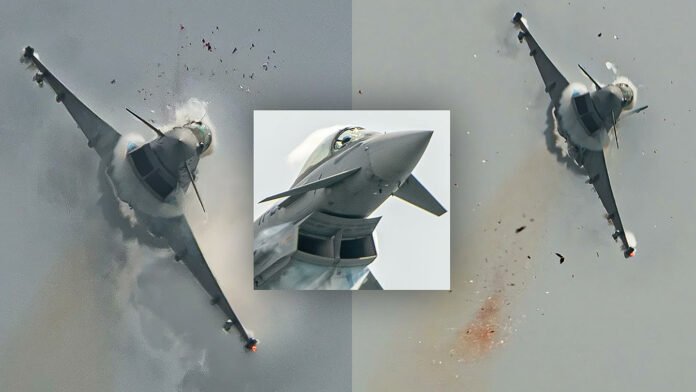Every year, tens of thousands of birds strike aircraft around the world, but not many of those are caught on camera. But one Spanish photographer captured some incredible images of just such an occurrence involving not just any plane, but a Spanish Air Force EF2000 Eurofighter Typhoon undergoing a high-performance air show routine. Bird strikes are dangerous for any aircraft, but especially for fighter aircraft. This is even more so the case for those flying low and maneuvering hard near a large crowd of people.
This particular strike happened at the Aire 25 air show in Spain last month. Javier Alonso de Medina Salguero was at the base of the spotter area, photographing the Spanish Eagle Patrol Eurofighter demonstration team, when he fired off a multi-shot sequence. He’s only recently posted them due to his hectic schedule.
The first shot shows what Salguero, whose work can be found on the air_spotter7200 Instagram account, told us was a Lesser Blacked-Backed gull flying in the path of the jet.

The second shot shows the immediate aftermath of the gull impacting the right side of the Eurofighter’s canopy and shattering into a shower of feathers and bone.

The third shot shows what appears to be a piece of the canopy falling away and a trail of blood, guts and feathers.

The fourth shot is a close-up of the broken forward canopy glazing.

Though photographing aviation for years, this was the first time Salguero ever saw a plane being struck by a bird.
“I was quite surprised,” about the incident and the quality of the images, said Salguero, who was using a Nikon 200mm-500mm lens at the time. “We were watching the exhibition of the Eurofighter when we saw that [it] left without finishing the exhibition. They reported by radio that he had hit a seagull and had broken the dome. Just at that moment I saw the photos I had and I saw the entire sequence.”
The Eurofighter was from the 11th Wing based in Morón, according to the Spanish Infodefensa news outlet. The event was being held to mark the 40th anniversary of the Eagle Patrol and was attended by Spanish King Felipe VI. The collision happened as the Eurofighter performed aerobatic maneuvers. You can see those, and the fleeting moment of impact in the following video, which shows far less detail of the strike.

https://www.youtube.com/watch?v=Sy72lDmwBKA&t=7s
After the collision, the Eurofighter left the air show and headed to the nearby San Javier Air Base. A team of specialists from the Spanish Air Force repair unit headed to the base to assess the damage, the publication noted.
While the pilot managed to survive, hundreds of people have died from crashes caused by bird strikes, while others have had to be rescued. One of the most famous of those incidents took place Jan. 15, 2009, when U.S. Airways Flight 1549 landed safely in the Hudson River after hitting a flock of geese. It made a hero of pilot Chesley “Sully” Sullenberger.

As we noted in the past, high-performance fighter jets are particularly susceptible to problems when encountering birds.
These strikes are especially dangerous for single-engine jets, which could lose all power while also suffering serious damage if they ingest a bird. This can happen to twin-engined fighters too, with multiple birds, but there is less margin for single-engine aircraft. The lower to the ground this happens, the less time there is to react and work the problem.
Considering the speeds that these aircraft fly and how busy their pilots are in the cockpit, sometimes birds aren’t even spotted before impact or cannot be avoided, as seen in the video below.

In fact, even if the bird doesn’t take down the jet, the pilot’s reaction to the strike could.
An amazing example of this is the photo seen below, taken by aviation photographer, air traffic controller, and veteran AWACS crewman, Louis DePaemelaere (check out his site here), at Buckley Air Force Base in Colorado.
The picture shows one of the 120th Fighter Squadron F-16Cs blasting out of Buckley and right into a small gathering of birds, one of which had a dramatic collision with the Viper’s ALQ-131 electronic countermeasures pod mounted on its centerline station. A bit higher and the result of such a collision could have been far more severe.

Bird strikes are of great concern to the military. Between 2007 and 2016, the Air Force and Navy reported an average of about 5,600 bird strikes per year, causing a total of nearly $400 million in damage over that period, according to the Pentagon’s Bird/Wildlife Aircraft Hazard (BASH) prevention program.
“Because pilots and crews use the same low-altitude airspace as large concentrations of birds, the prevention of bird strikes is of serious concern to the military,” BASH noted.
“The primary BASH programs are implemented at the installation level and operated currently by Air Force and Navy,” BASH explained. “These programs include unique installation-level BASH teams comprised of military and civilian personnel from air operations, aviation safety, and natural resources that work together to reduce BASH risk.”

The Eurofighter pilot was lucky. So too was Salguero. Though he only recently posted the images, they have received a lot of praise.
“I didn’t expect that my photos would reach so many people,” he said, offering a simple explanation for why it took so long for them to emerge.
“I should have published them before,” he explained. “But I haven’t had much time.”
Contact the author: howard@thewarzone.com
